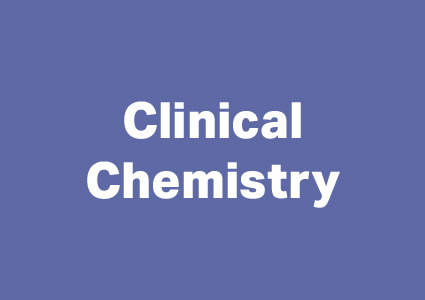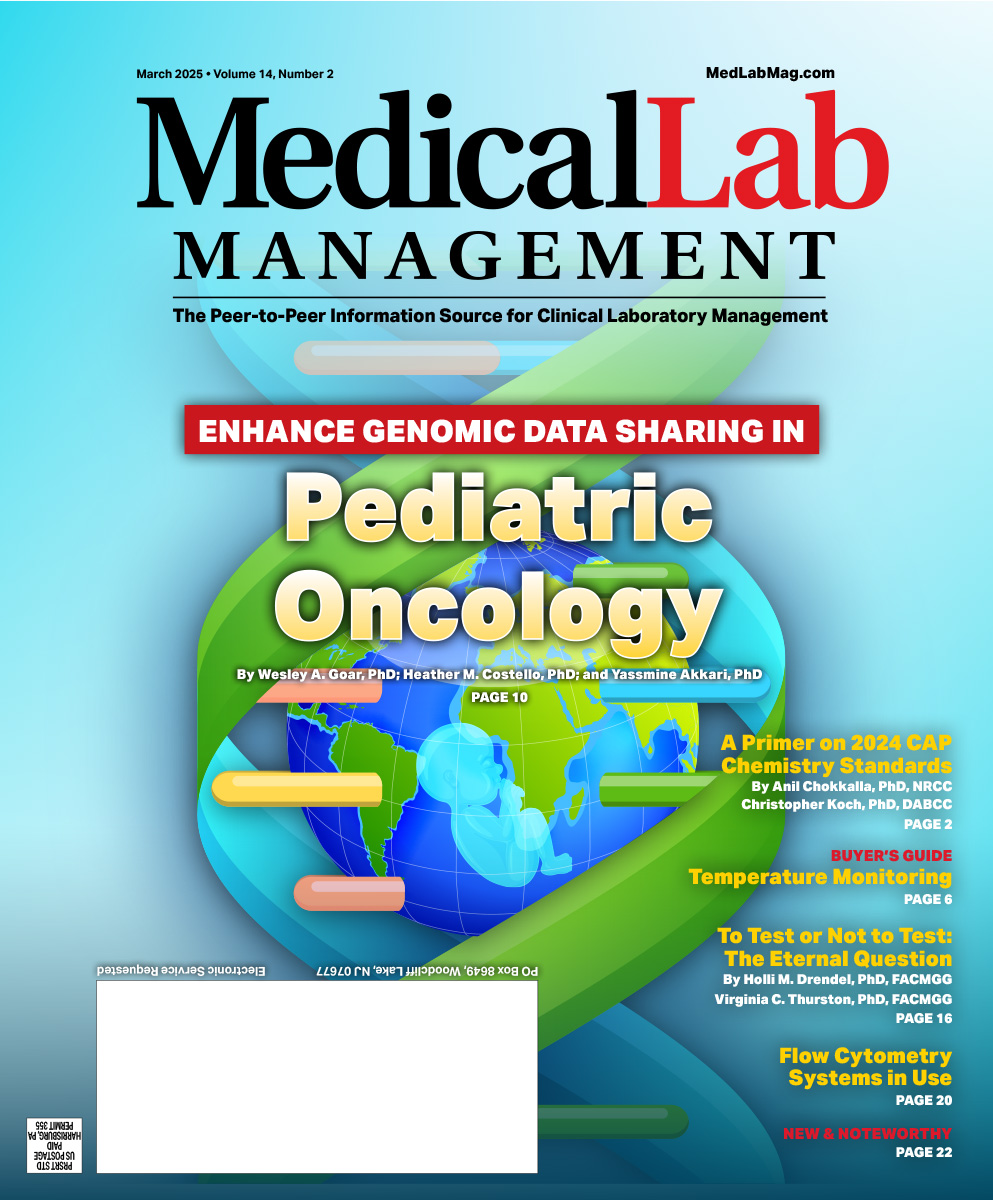- Show Menu
- Contact Us
- FAQs
- Reader Service
- Survey Data
- Survey Winners
- Testimonials
- Upcoming Events
- Webinars
Microbiology Laboratory Planning and Design
In reviewing this year’s most popular articles by digital views, we were intrigued by the most popular articles of all time. Currently in second place is the following piece that first appeared in the May 2019 issue of MLM (medlabmag.com/article/1570).
Dr. Wolk serves as the division chief of molecular and microbial diagnostics and development at Geisinger Medical Laboratories. We present this piece in memory of our friend and co-author, Ted Newell, AIA.
For many years, automation in the clinical microbiology laboratory has lagged behind other laboratory disciplines. Automation has revolutionized the clinical core laboratory, including chemistry, hematology, coagulation, and immunology, with testing instruments connected to tracks and routing conveyors, all managed in precise detail by computer. In contrast, many microbiologists continue to open specimen containers by hand and grow bacteria using incubators, and manually inspect agar plates for bacteria growth with manual follow up. But, this is changing, and new developments in microbiology automation are impacting the way we design and plan microbiology laboratory spaces.
The Evolving Microbiology Laboratory
Advances in science and technology have led to the development and widespread clinical application of molecular diagnostics, digital microbiology, mass spectrometry (MS), MALDI-TOF, and total laboratory automation (TLA) systems. Taking an architectural and engineering aspect, these advances are having a tremendous impact on modern day microbiology laboratory design and build. At Geisinger Diagnostic Medicine Institute in Danville, Pennsylvania, the laboratory features numerous disciplines working together in a large space, and when they had the opportunity to rearrange their microbiology operations, they took a critical eye to both current operations, and future plans to adopt automation.
Clinical microbiology historically requires intake, management, and output on a diversity of patient specimen types (eg, stool samples, respiratory secretions, etc). Samples arrive in multiple tube variants or on swabs in different sized containers requiring logistical operations. Once specimens are received in micro, a lengthy culturing process may be necessary, including visual inspection before final results can be produced. The considerable variability in the culture process has traditionally hampered standardization—a requirement for automation—but new transport devices have been developed in recent years for certain specimen types that support automation and its attendant benefits, including expedited results and the ability to detect and identify a greater number of organisms, faster. As an example, actionable results on flu molecular tests previously required at least multiple days, but are now available in as little as 20 minutes, driving both antiviral and to some extent, antibiotic therapy.
The microbiology regulatory environment also has changed in recent years with the FDA approving additional test options, thereby broadening microbiology test menus. (Some of these are FDA approved directly, whereas others are validated only by individual laboratories; ie, laboratory developed tests or LDTs.) Given that microbiology lab results directly influence not only inpatient management, but also the decision to admit or isolate a patient in the first place, the practice of clinical microbiology must remain on the forefront of patient medical diagnosis and treatment strategies, and therefore requires careful attention to physical operations and clinical workflow.
Examine Microbiology Workflow
Fundamentally, a keen interpretation of workflow should drive a solid design in all clinical operations. This includes an understanding of intra-laboratory relationships, block planning, and schematic design toward a common goal of efficiency and economy. As such, we can examine the dimensions of workflow in a modern microbiology laboratory moving from general to specific.
In this case, Geisinger wanted its three main types of clinical microbiology laboratory practice to work seamlessly together:
- Stat molecular microbiology (eg, infectious disease molecular diagnostics, rapid MRSA testing, minimum inhibitory testing [MIC], etc)
- Traditional microbiology including blood cultures (eg, cultures, direct stains, microscopy, antigen testing, etc)
- Batch molecular microbiology (eg, once a day or once per shift)
At a high level, specimens are received, sorted, and routed to one of these three areas of processing. When planning a design, we further breakdown the workflow as moving from a central receiving and processing (RAP) area to specific processes taking place in the molecular stat laboratory, bacteriology, batch micro-molecular, a biosafety-level 3 laboratory (not discussed in this article), and non-microbiology molecular diagnostics that may share instruments with molecular microbiology.
When considering how these elements work together, the workflow can be illustrated using a more detailed relationship diagram. From this diagram, we can then develop a block plan, wherein function blocks are strategically arranged for each process, sized to represent the workload of the function, and physically placed to best accommodate workflow as demonstrated by arrows (see FIGURE 1).

Click here to view a larger version of this chart.
Outlining Pre-Automation Workflow with Specialty Locations
Beginning with the general laboratory RAP area (sometimes referred to as a clerical or specimen accessioning area) where all lab specimens are received, accessioned, and divided into the various disciplines in the lab, we see that specimens arrive in various containers, frequently with a coolant, and some of these containers must be returned. The specimens are then commonly moved to a general separation area and sorted with the microbiology specimens sent to the micro RAP area and on to the appropriate microbiology workspaces. Other specimens are sent to their appropriate laboratory section. Within microbiology, there are smaller, adjacent labs for operations specific to stat molecular diagnostics and blood cultures. These smaller labs must work in harmony with the main microbiology processing lab.
Molecular Stat Lab
The stat micro-molecular laboratory is located adjacent to the general laboratory RAP area for efficient specimen transport. Once specimens are received, they are loaded onto the instruments for infectious disease molecular diagnostics, rapid MRSA testing, and minimal inhibitory concentrations (MIC) for positive blood cultures, among other determinations. By using this combination of instrumentation in an open and collaborative setting, most results are produced in two hours or less and can be communicated to clinicians for treatment decisions and to facility operations (via a bed management dashboard) for admission/isolation or discharge decisions.
Blood Cultures Lab
Pre-inoculated blood cultures are routed directly from the Micro RAP work stations to the blood cultures laboratory where they are loaded on to instruments for incubation. These results are made available in as little as 6-24 hours of bacteria discovery (some results may take longer) and negative cultures are incubated here for a total of five days. Positive blood cultures are moved to the stat molecular area for testing and processing, including Gram staining before being incubated and routed to bacteriology.
Future Planning for Automation
In the traditional bacteriology laboratory, specimens are manually moved to incubators in one area of the bacteriology laboratory, then to manual workstations in another area. These workstations attend to several specimen types, including urines, wound swabs, respirators, anerobes, ganstrointestial, etc. From these workstations, specimens are sent to identification stations, MALDI-TOF mass spectrometry and to antimicrobial susceptibility testing (AST) areas, as well as Kirby-Bauer (disk diffusion) testing, and so on. However, in a total laboratory automation (TLA) system, specimens are placed on a conveyor and delivered to a number of workstations for automated plate streaking, incubation, and digital imaging of culture colonies.
The microbiology laboratory at Geisinger was initially designed to accommodate manual work ups at workstations distributed along a narrow corridor, but which would also accommodate a TLA system without major changes to the laboratory space.
Automation Arrangement
The TLA workflow system housed in the main microbiology laboratory at Geisinger comprises six modules:
- Media storage and distribution
- Bar code identification
- Inoculation
- Two-way conveyor linking all modules
- Normal incubation and CO2 incubation, with digital imaging
- Workbenches
This molecular laboratory is designed to accommodate PCR technology in a uni-directional workflow that includes a reagent preparation room and a separate sample preparation room. This separation is necessary to prevent the reagents from being contaminated by patient samples. Both the sample prep and reagent prep labs have separate entrances, and both have entrances to the amplification and detection lab.
Conclusion
The trend toward incorporating automation lines into microbiology practice has been supported by novel robotics and advancements in molecular diagnostics, digital imaging, and mass spectrometry. With the modularity afforded by the TLA system, Geisinger plans to incorporate AST and MALDI-TOF functions into the automation line.
In the past, the diverse nature of microbiology specimens paired with lengthy and manual culturing process and human review hindered the standardization required for automation to be effective. However, breakthroughs in molecular diagnostics are changing the limitations on standardization and automation in microbiology and allowing the laboratory to identify more pathogens faster without many of the impediments of past culturing processes. Treatment can now begin as soon as a pathogen is identified, eliminating lost time and effort spent utilizing broad spectrum and sometimes ineffective antibiotics.
Microbiology is no longer focused on confirmatory testing, but is engaged in the mainstream of lab workflow and should be designed at the forefront of specimen delivery. This physical structuring has important implications for planning and designing the laboratory space. Microbiology should no longer be located away from the center of the laboratory in disparate areas; rather, it should be afforded a prominent place in your laboratory space. By continuing to refine existing practices, gain standardization, and adopt the latest technologies, automation can truly benefit the microbiology lab.

Ted Newell, AIA, NCARB, AABB, was principal at Ted Newell, Architect and Planner, and a former partner at EwingCole in Philadelphia. A laboratory design innovator for over 30 years, he displayed leadership in the programming, planning, and design of complex facilities for clinical laboratory and anatomic pathology practices. Ted was a compassionate advocate for healthcare design that benefitted both workers and patients, and he was a friend of MedicalLab Management. He passed away in 2021.

Donna M. Wolk, MHA, PhD, (D(ABMM), is division chief of molecular and microbial diagnostics and development at Geisinger Medical Laboratories in Danville, Pennsylvania. She serves on the Clinical Laboratory Improvement Advisory Committee (CLIAC) managed by the CDC, to provide scientific and technical guidance to the US DHHS. Dr. Wolk also is the lead investigator for Geisinger’s Center for Laboratory Innovations and Outcomes, and chair of the Diagnostic Medicine Institute’s Clinical Research Council.
Like what you've read? Please log in or create a free account to enjoy more of what www.medlabmag.com has to offer.








